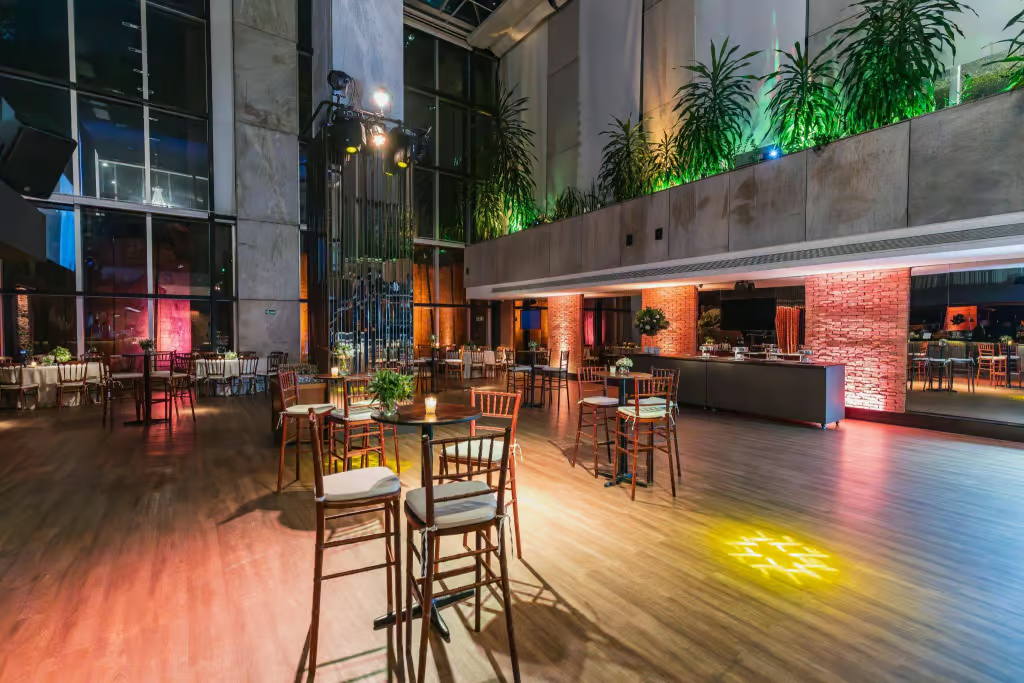Due to its remarkable energy efficiency, LED has become the holy grail of lighting technology. Businesses and homeowners alike are adopting LED lighting at an exhilarating pace. By 2030, some experts say 87% of all lighting worldwide will be LEDs.
But with such mass adoption comes the need to truly understand LEDs and the key terms surrounding the technology to guide your purchasing decisions.
For businesses, going into the LED space blind can be costly as they can end up spending money on solutions that don’t meet their needs.
That’s why we are here today. To explain these three key LED lighting terms (lumen, wattage, and color temperature). We’ll go a mile further and explain other key terms, how they work together, and how to pick the right LED products.
What Are LED Lighting Terms and Why Do They Matter?
Knowing these terms isn’t just about improving your technology-related lingo. It’s much more than that. These terms give you an exclusive insight into how LED technology works.
This basically allows you to make the right purchasing choices for your organization. You can save hundreds to thousands of dollars by making the right decisions the first time, and that is the benefit of knowing these key terms.
The main terms we came to discuss (lumen, wattage, and color temperature) dictate everything from energy efficiency to the comfort and mood of a room.
Without a clear understanding of these terms, you may end up with lighting that consumes too much energy, provides insufficient illumination, or creates an unwanted ambience.
Let’s explore these key LED lighting terms below

Lumen: Measuring Light Output
The lumen is a critical measurement for determining the brightness of a light source. Unlike traditional lighting, which focuses on wattage to gauge brightness, LEDs rely on lumens to give a more accurate idea of light output.
Definition
When you measure the lumens of an LED bulb, you are measuring the amount of visible light emitted from a source.
Lumens are fundamentally different from Watts which measure energy instead.
Since lumens are a measurement of light, an LED with fewer lumens will be less bright than one with more lumens.
Example
A standard 60W incandescent bulb typically produces around 800 lumens, which is a simple measurement of how much light the bulb is emitting.
Misconceptions
One popular misconception is that wattage is a measure of brightness.
In reality, wattage only tells you how much energy a light source consumes. Brightness is measured in lumens.
Guide
For homes, 800-1000 lumens is often sufficient for general use, but for larger spaces like offices, you might need LED bulbs offering 2000 lumens or more.
Wattage: Understanding Energy Consumption
Wattage is a topic of confusion for many.
They believe it to be a measure of how much power a bulb can produce, but in fact, it indicates energy consumption.
It doesn’t tell you what you get in terms of brightness but instead tells you what you’ll spend on energy costs.
Understanding wattage is crucial to knowing how much electricity a light source uses and what your energy costs will look like.
Definition
Wattage simply measures how much energy a source consumes per second to produce light.
It’s self-evident that lower wattage for the same amount of lumen output is more energy-efficient, and thus, more desirable for businesses.
Comparison
Traditional incandescent bulbs use significantly more energy than their LED counterparts.
For example, while a 60W incandescent bulb produces 800 lumens, a 9W LED can generate 900 lumens, even more for a fraction of the energy consumption.
Tips
When selecting LED lighting, focus on low-wattage bulbs with high-lumen output. This ensures bright, energy-efficient lighting that cuts down electricity bills without sacrificing quality.
Color Temperature: Setting the Mood

Color temperature deals with the warmness and coolness of the light produced.
Remember that when we discuss warmness and coolness here, we are talking about the color (yellow to blue) of the light and not the temperature (hot or cold).
A simple definition of color temperature describes it as a scale by which we measure the warmness (yellowness) and coolness (blueness) of the light produced.
This is measured in Kelvin (K). The color temperature scale can directly influence the ambiance and functionality of a space.
Examples
Here are various common temperatures and the ideal environment to use them:
- Warm white (2700K-3000K) is often used in living rooms and bedrooms, creating a cozy, relaxed atmosphere.
- Cool white (4000K-5000K) is ideal for places like workspaces, kitchens, and offices. These are places where clarity and focus are required.
Common Questions
Let’s address some common questions people ask about color temperature below:
Is color temperature the same as lumens?
No, color temperature is not the same as lumens, rather, they measure different aspects of light.
Lumens quantify brightness, while color temperature relates to the hue and tone of the light. Both factors work together to create the desired environment.
Can you adjust the color temperature for all LED lights?
Not all LED lights come with adjustable color temperature. When purchasing LED lights, check the packaging or consult the supplier to find out if it is color temperature adjustable.
Guide
Here is a short guide on selecting the right color temperature based on the environment and desired ambiance:
- In living areas, aim for 2700K-3000K to get a relaxing ambiance.
- In offices, 4000K-5000K lighting is better suited for concentration and productivity.
How Lumens, Wattage, and Color Temperature Work Together

Explanation
Lumens, wattage, and color temperature may be separate aspects, but they must work side-by-side to provide the desired lighting effect.
The brightness (lumens) you need, the energy you want to save (wattage), and the atmosphere you want to create (color temperature) must all align to achieve the optimal lighting solution.
Ideally, you’d want LED lights that offer high lumens for low wattage while having a broad range in color temperature. Understanding your needs is essential for picking an LED that is the perfect balance for you.
Examples
For example, in an office, you might want high lumens (brightness) with low wattage (energy efficiency) and a cooler color temperature (for productivity).
In contrast, a restaurant might opt for medium lumens, warm color temperatures, and energy-efficient lighting to create a cozy atmosphere.
You can combine 800 lumens with 10W and a 2700K color temperature for soft, energy-efficient lighting in a lounge. On the other hand, 1500 lumens with 12W and 4000K will be ideal for a well-lit office environment.
Application
Consider your lighting needs based on space usage. For outdoor lighting, you’ll want high lumens with moderate color temperatures for visibility without harsh glare.
For home offices, a balance between medium lumens and a cooler color temperature improves productivity.
Other Essential LED Lighting Terms

While lumens, wattage, and color temperature are key terms that are commonly misunderstood, you should learn these other important terms to properly evaluate LED lighting solutions.
- CRI (Color Rendering Index): This measures how accurately colors are rendered by the light source. A CRI of 80 or above is typically recommended for indoor use.
- Beam Angle: This refers to the spread of light emitted. A narrow beam (less than 60 degrees) is great for focused lighting, while a wider beam (greater than 100 degrees) is better for general lighting.
- Dimmability: Many LED lights can be dimmed with simple dimmer switches. This allows you to adjust the brightness levels to suit different moods and times of day.
Considerations
A key part of saving costs is taking time to consider your actual business needs to determine what kind of products to acquire. Considerations are what save you extra tips and costs in returns and new purchases.
There are several things to consider alongside the lumens, watts, color temperature, CRI, beam angle, and dimmability. Consider the following:
- What do you or your business intend to do with the space?
- How much space is there between the hung lights and the ground level?
- Consider the necessity of the feature.
Choosing the Right LED Light

With all these terms in mind, how do you choose the right LED lighting for your business or home?
Start by assessing your space and lighting needs.
Determine the appropriate lumen output based on the size of the room, choose a color temperature that fits the ambiance you’re aiming for, and select a wattage that meets your energy efficiency goals.
Checklist for picking the right LED lights:
- Define the purpose of the room (work, relaxation, display).
- Determine the desired brightness (lumens).
- Choose the right color temperature (Kelvin).
- Ensure energy efficiency with the appropriate wattage.
- Consider additional features such as dimmability and CRI.
Conclusion
Understanding is power. In our case, understanding empowers you to make the right decisions for businesses looking for lighting solutions.
It could even be for homes or outdoor settings, and the point will still stand. Just understanding a few basic terms can save you hundreds to thousands of dollars by eliminating cost refunds and new purchases.
The benefits of knowing these terms go beyond saving money and energy costs. Through proper lighting alone, businesses can raise the productivity of employees with light that improves the ambiance and boosts focus.
Use this guide to ensure your lighting solutions are practical and sustainable while enhancing the experience for everyone in the space.
Sourcing should now be your only problem. Check out OLAMLED, an industry-leading LED lighting solutions company.



